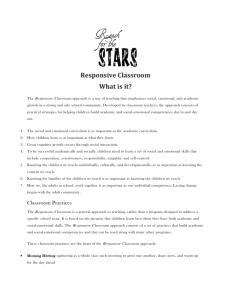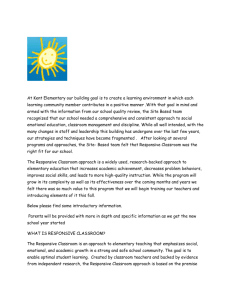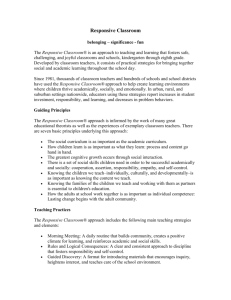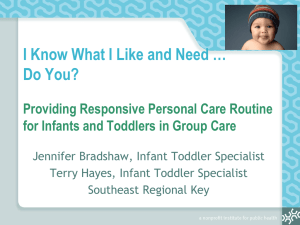The Responsive Classroom Approach
advertisement
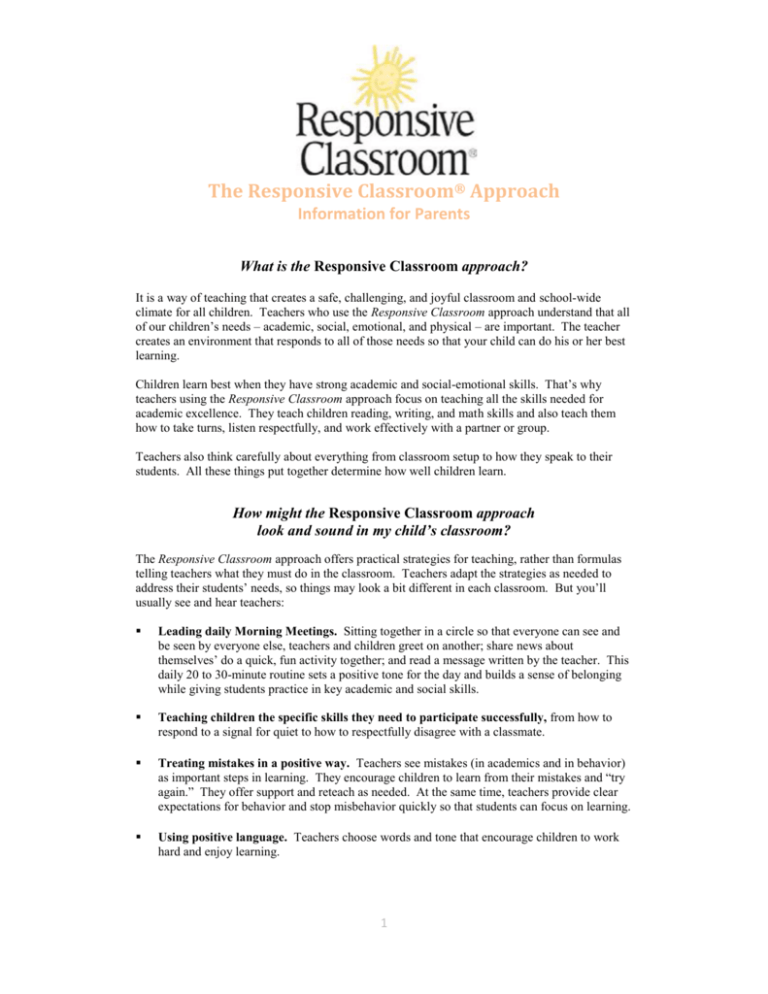
The Responsive Classroom® Approach Information for Parents What is the Responsive Classroom approach? It is a way of teaching that creates a safe, challenging, and joyful classroom and school-wide climate for all children. Teachers who use the Responsive Classroom approach understand that all of our children’s needs – academic, social, emotional, and physical – are important. The teacher creates an environment that responds to all of those needs so that your child can do his or her best learning. Children learn best when they have strong academic and social-emotional skills. That’s why teachers using the Responsive Classroom approach focus on teaching all the skills needed for academic excellence. They teach children reading, writing, and math skills and also teach them how to take turns, listen respectfully, and work effectively with a partner or group. Teachers also think carefully about everything from classroom setup to how they speak to their students. All these things put together determine how well children learn. How might the Responsive Classroom approach look and sound in my child’s classroom? The Responsive Classroom approach offers practical strategies for teaching, rather than formulas telling teachers what they must do in the classroom. Teachers adapt the strategies as needed to address their students’ needs, so things may look a bit different in each classroom. But you’ll usually see and hear teachers: Leading daily Morning Meetings. Sitting together in a circle so that everyone can see and be seen by everyone else, teachers and children greet on another; share news about themselves’ do a quick, fun activity together; and read a message written by the teacher. This daily 20 to 30-minute routine sets a positive tone for the day and builds a sense of belonging while giving students practice in key academic and social skills. Teaching children the specific skills they need to participate successfully, from how to respond to a signal for quiet to how to respectfully disagree with a classmate. Treating mistakes in a positive way. Teachers see mistakes (in academics and in behavior) as important steps in learning. They encourage children to learn from their mistakes and “try again.” They offer support and reteach as needed. At the same time, teachers provide clear expectations for behavior and stop misbehavior quickly so that students can focus on learning. Using positive language. Teachers choose words and tone that encourage children to work hard and enjoy learning. 1 Teaching in ways that build excitement about learning. Teachers give children some choices in their learning (“You may paint or write to show what you’ve learned about insects’). They also plan some active lessons (ones that get children up and moving) and interactive lessons (ones that encourage children to share their information, ideas, and questions). Giving children opportunities to reflect on their learning. Teachers ask children to think about what they’ve learned, both individually and as a group, because doing so helps children learn more and builds community. Reaching out to parents. Teachers communicate often with parents and welcome them as partners in their child’s education. How do you know it works? Over the past thirty years, teachers who use Responsive Classroom strategies have reported significant improvements in their students’ learning and behavior. And researchers, as well as teachers, have found that children: Achieve higher scores on math and reading tests Have better social skills (listening, disagreeing respectfully, waiting for a turn, etc.) Feel more positive about school, teachers, and peers. Where did the Responsive Classroom approach come from? A group of public school educators began developing it in 1981, building on the best research about how children learn. Over the years, the approach has been refined to reflect the most current and useful knowledge about children. Who uses this approach? Thousands of teachers and school leaders in elementary schools across the United States and in Canada use Responsive Classroom practices. What social skills do teachers focus on? Children learn academics most easily when they have strong social skills that let them take a positive role in classroom life. For example, the social skill of listening respectfully helps children learn from classmates’ oral reports, get information from their teacher about how to solve a math problem, and enjoy a book the teacher reads aloud to the class. Here are some of the specific social skills that teachers focus on teaching throughout the year and teach with special emphasis during the early weeks of school: Cooperation (working smoothly with others) Assertiveness (confidently putting forth your ideas and opinions) 2 Responsibility (taking charge of yourself and working hard at your learning) Self-control (thinking before acting) Empathy (listening to others and understanding how they might respond to your words or actions) How do teachers teach these skills? Teachers understand that children may not come to their classrooms knowing how to take turns, listen, disagree respectfully, walk quietly in a hallway, or do many other things that reflect positive school behavior. To help the children learn, teachers will carefully: Break skills and tasks into small parts Briefly describe the behavior they’re looking for Model the behavior themselves and then ask children to model it Give the children plenty of practice and feedback Reteach as necessary throughout the year. When do teachers teach these skills? Teachers weave social skills teaching into everything the children do – academics, recess, lunch and even entering and leaving the school building and classroom. During a math lesson, for example, second graders learn how to count money while also learning how to listen respectfully to a classmate’s idea for how to solve a problem. During recess, children of all ages learn how to include everyone in their games. Although teachers help students learn social skills throughout the school year, they focus most strongly on teaching these skills during the first six weeks of school. It’s during this time that expectations for behavior are clearly laid out and children are taught how to meet these expectations. When teachers take the time to teach and model these skills well in the beginning of the year, they spend less time on behavior problems and more time on learning all year long. What about classroom rules? During the first weeks of school, teachers and children create rules based on the children’s goals for learning. First, children name an academic or social skill they’d especially like to work on during the coming months – for example, reading harder books or making new friends. Then teacher and students discuss how life in the classroom needs to look and sound so everyone can meet their goals. Together, they create a few simple, positively stated rules that they all agree to follow, such as Take care of yourself, Take care of your classmates, Take care of our classroom. Children follow the rules more willingly because they helped to make them. Teachers refer to the rules many times throughout the day and year, helping children understand how following the rules helps everyone to learn. Some schools also have a few basic school-wide rules that everyone follows in the hallways, lunchroom, and other common spaces. 3 What do teachers do when children break the rules? Teachers understand that all children will, at one time or another, test or break the rules. When that happens, teachers discipline firmly but kindly and positively. The goals are (1) to stop the misbehavior as quickly as possible so that the child (and classmates) can get back to learning and (2) to teach the child to reflect on and control his or her own behavior. The Responsive Classroom approach offers teachers many tools to help children control their own behavior and contribute to the classroom community. One very important tool is clear, positive language. When children are just beginning to go off course, teachers use reminding language (Karen, what should you be doing right now?). When children are clearly misbehaving, teachers use redirecting language (Mike, hands in your lap). And when children are doing well, teachers use reinforcing language (I noticed that you cleaned up very quickly today). Teachers also make sure that the consequences for misbehavior are related to the misbehavior and respectful of the child. For example, if a child writes on a desk, having the child clean the desk makes sense. Keeping the child in from recess does not make sense. Many teachers also use time-out (although the children may decide on a different name, such as take-a-break) to help children regain control when they’re just beginning to lose it. Time-out offers children a quick way to calm down, relax, and rejoin the class with dignity – it’s not a punishment. How can I learn more about the Responsive Classroom approach? Visit the Responsive Classroom website. You’ll find information about the approach and how teachers learn to use it. You can also watch video clips of Responsive Classroom in action in real classrooms. www.responsiveclassroom.org Take a look at these books: The Power of Our Words: Teacher Language That Helps Children Learn by Paula Denton; Yardsticks: Children in the Classroom Ages 4-14 by Chip Wood; Sammy and His Behavior Problems: Stories and Strategies from a Teacher’s Year by Caltha Crowe. Your child’s school may have copies to lend you. You can also purchase the books at the Responsive Classroom website. Explore the Responsive blog, where teachers share ideas about using Responsive Classroom strategies. www.responsiveclassroom.org/blog Become a fan on Facebook – or just look around to see what’s going on in the Responsive Classroom world. www.facebook.com/responsiveclassroom 4

